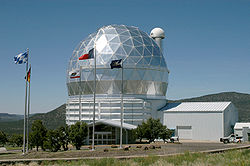Top Qs
Timeline
Chat
Perspective
List of largest optical reflecting telescopes
From Wikipedia, the free encyclopedia
Remove ads
This list of the largest optical reflecting telescopes with objective diameters of 3.0 metres (120 in) or greater is sorted by aperture, which is a measure of the light-gathering power and resolution of a reflecting telescope. The mirrors themselves can be larger than the aperture, and some telescopes may use aperture synthesis through interferometry. Telescopes designed to be used as optical astronomical interferometers such as the Keck I and II used together as the Keck Interferometer (up to 85 m) can reach higher resolutions, although at a narrower range of observations. When the two mirrors are on one mount, the combined mirror spacing of the Large Binocular Telescope (22.8 m) allows fuller use of the aperture synthesis.
Largest does not always equate to being the best telescopes, and overall light gathering power of the optical system can be a poor measure of a telescope's performance. Space-based telescopes, such as the Hubble Space Telescope, take advantage of being above the Earth's atmosphere to reach higher resolution and greater light gathering through longer exposure times. Location in the northern or southern hemisphere of the Earth can also limit what part of the sky can be observed, and climate conditions at the observatory site affect how often the telescope can be used each year.
The combination of large mirrors, locations selected for stable atmosphere and favorable climate conditions, and active optics and adaptive optics to correct for much of atmospheric turbulence allow the largest Earth based telescopes to reach higher resolution than the Hubble Space Telescope.[1] Another advantage of Earth based telescopes is the comparatively low cost of upgrading and replacing instruments.

Remove ads
Table of reflecting telescopes
Summarize
Perspective
Telescopes in this list are ordered by effective optical aperture, given as the diameter of a circle with equivalent collecting area. Aperture has historically been a useful gauge of telescopes' limiting resolution, optical area, physical size, and cost. Multiple mirror or segmented mirror telescopes that are on the same mount and usually form a single combined image are ranked by their equivalent combined aperture. Telescopes that cannot use their entire primary mirror at once (e.g. HET or LAMOST) are listed by their maximum effective aperture. Telescopes that are sometimes used for optical interferometry are listed individually, not as a combined instrument. All telescopes with an effective aperture of at least 3.00 metres (118 in) at visible or near-infrared wavelengths are included; selected smaller telescopes are listed elsewhere.
Remove ads
Chronological list of largest telescopes
These telescopes were the largest in the world at the time of their construction, by the same aperture criterion as above.

Remove ads
Future telescopes
Summarize
Perspective
Under construction

These telescopes are under construction and will meet the list inclusion criteria once completed:
- Extremely Large Telescope, Chile – 39.5 m (1,560 in). Construction began in 2018, first light planned in 2029.[22]
- Thirty Meter Telescope, Hawaii, USA – 30 m (1,200 in). Construction began in 2014 but halted in 2015; as of 2022[update] it has not resumed.[23]
- Giant Magellan Telescope, Chile – seven 8.4 m mirrors on a single mount. This provides an effective aperture equivalent to a 21.4 m mirror and the resolving power equivalent to a 24.5 m mirror. First light planned in 2029.[24]
- San Pedro Martir Telescope, Baja California, Mexico – 6.5 m (260 in). First light planned in 2023.[25][needs update]
- Magdalena Ridge Observatory Interferometer, New Mexico, USA – An optical interferometer array with ten 1.4 m (55 in) telescopes. The light gathering power is equivalent to a 4.4 m (170 in) single aperture. The first telescope was installed in 2016; construction was paused in 2019 due to insufficient funding[26] and has not resumed.
- Timau National Observatory, Indonesia – 3.8 m (150 in). Construction expected to be completed by early 2025.[27][needs update]
Proposed
Selected large telescopes which are in detailed design or pre-construction phases:
- Habitable Worlds Observatory (LUVOIR), a proposed space telescope for launch in the early 2040s.[citation needed]
- MUltiplexed Survey Telescope (MUST), a 6.5 m spectroscopic survey telescope.[28]
- Chinese Giant Solar Telescope (CGST), an infrared and optical solar telescope, with light-gathering power equivalent to a 5 m diameter aperture.[29][30]
See also
References
Further reading
External links
Wikiwand - on
Seamless Wikipedia browsing. On steroids.
Remove ads



















